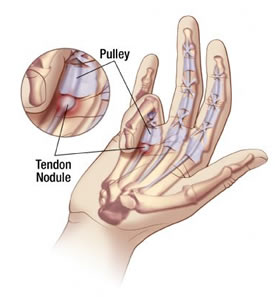Trigger Finger
Trigger finger (or thumb) is a condition where a finger repeatedly clicks or gets stuck in a bent position. There is tenderness or pain in the palm and with movement of the finger, especially straightening. Some people have to use their other hand to straighten out a trigger finger when it locks. This problem may occur after doing a repetitive or heavy activity with the hand but can also occur without any obvious cause. It is more common in people with diabetes. Trigger finger initially may be only a minor inconvenience but can progress to a locked finger, where it is not possible to straighten the finger.
Trigger finger is due to the tendon in the finger getting stuck as it passes under a tight ligament called a pulley. The pulley (called the A1 pulley) is at the base of the finger in the palm of the hand. Trigger finger develops in most cases due to inflammation of the tendon which then makes it too thick to glide easily through the pulley.
Treatment
Trigger finger sometimes resolves without treatment but when this does occur it is often very slow.
One treatment approach is to immobilize the involved finger or fingers in a hand based splint called a P1 blocking splint. This prevents the MP joint (first joint) of the finger from bending. By splinting this joint in extension, or straight, the inflamed part of the tendon cannot move through the pulley, allowing the swelling to resolve on its own. To be effective the splint should be worn for about 6 weeks. This approach is most effective if the condition is acute and has not continued for many weeks or months. Anti-inflammatory medication may be used at the same time and avoiding aggravating activities is also important.
A steroid injection is another effective treatment for mild cases and those of short duration.
Surgery my be advised for more severe cases of trigger finger. It is a fairly quick procedure and usually requires only one small incision for each finger involved. In surgery the tunnel, through which the flexor tendons pass, is released allowing the tendons to glide freely. This procedure is performed under local anesthesia and depending on the amount of swelling, stiffness, scarring and pain the surgeon may refer the patient for Hand Therapy. Generally speaking, if Hand Therapy is required, it is usually short in duration.
If you have questions about Trigger Finger or anything related to Hand Therapy please feel free to contact us at your convenience.











